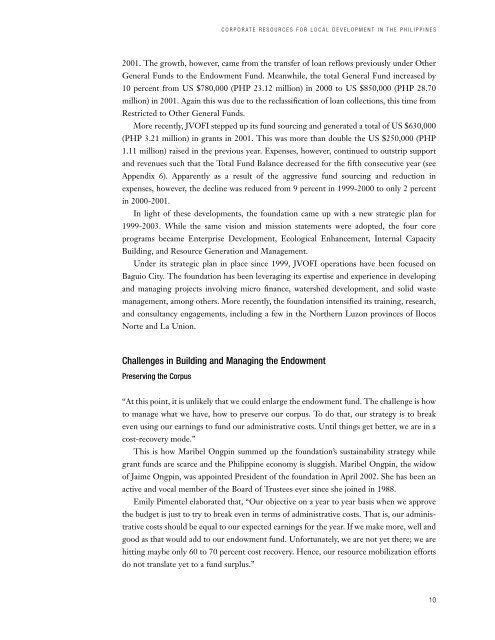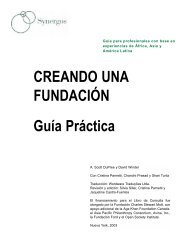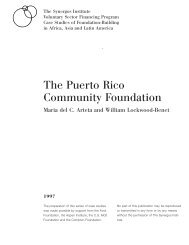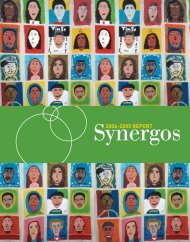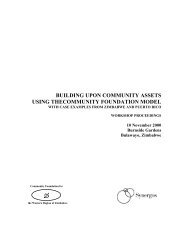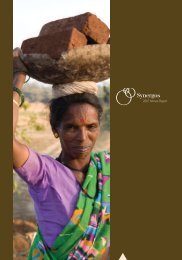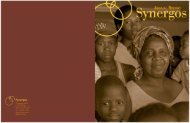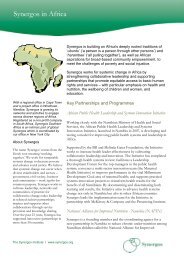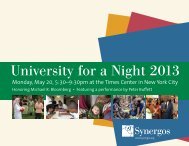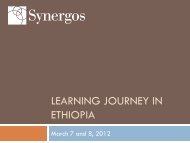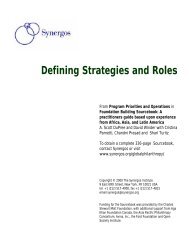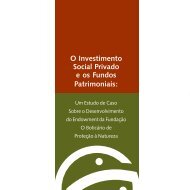Download full text of paper (PDF) - Synergos
Download full text of paper (PDF) - Synergos
Download full text of paper (PDF) - Synergos
You also want an ePaper? Increase the reach of your titles
YUMPU automatically turns print PDFs into web optimized ePapers that Google loves.
CORPORATE RESOURCES FOR LOCAL DEVELOPMENT IN THE PHILIPPINES<br />
2001. The growth, however, came from the transfer <strong>of</strong> loan reflows previously under Other<br />
General Funds to the Endowment Fund. Meanwhile, the total General Fund increased by<br />
10 percent from US $780,000 (PHP 23.12 million) in 2000 to US $850,000 (PHP 28.70<br />
million) in 2001. Again this was due to the reclassification <strong>of</strong> loan collections, this time from<br />
Restricted to Other General Funds.<br />
More recently, JVOFI stepped up its fund sourcing and generated a total <strong>of</strong> US $630,000<br />
(PHP 3.21 million) in grants in 2001. This was more than double the US $250,000 (PHP<br />
1.11 million) raised in the previous year. Expenses, however, continued to outstrip support<br />
and revenues such that the Total Fund Balance decreased for the fifth consecutive year (see<br />
Appendix 6). Apparently as a result <strong>of</strong> the aggressive fund sourcing and reduction in<br />
expenses, however, the decline was reduced from 9 percent in 1999-2000 to only 2 percent<br />
in 2000-2001.<br />
In light <strong>of</strong> these developments, the foundation came up with a new strategic plan for<br />
1999-2003. While the same vision and mission statements were adopted, the four core<br />
programs became Enterprise Development, Ecological Enhancement, Internal Capacity<br />
Building, and Resource Generation and Management.<br />
Under its strategic plan in place since 1999, JVOFI operations have been focused on<br />
Baguio City. The foundation has been leveraging its expertise and experience in developing<br />
and managing projects involving micro finance, watershed development, and solid waste<br />
management, among others. More recently, the foundation intensified its training, research,<br />
and consultancy engagements, including a few in the Northern Luzon provinces <strong>of</strong> Ilocos<br />
Norte and La Union.<br />
Challenges in Building and Managing the Endowment<br />
Preserving the Corpus<br />
“At this point, it is unlikely that we could enlarge the endowment fund. The challenge is how<br />
to manage what we have, how to preserve our corpus. To do that, our strategy is to break<br />
even using our earnings to fund our administrative costs. Until things get better, we are in a<br />
cost-recovery mode.”<br />
This is how Maribel Ongpin summed up the foundation’s sustainability strategy while<br />
grant funds are scarce and the Philippine economy is sluggish. Maribel Ongpin, the widow<br />
<strong>of</strong> Jaime Ongpin, was appointed President <strong>of</strong> the foundation in April 2002. She has been an<br />
active and vocal member <strong>of</strong> the Board <strong>of</strong> Trustees ever since she joined in 1988.<br />
Emily Pimentel elaborated that, “Our objective on a year to year basis when we approve<br />
the budget is just to try to break even in terms <strong>of</strong> administrative costs. That is, our administrative<br />
costs should be equal to our expected earnings for the year. If we make more, well and<br />
good as that would add to our endowment fund. Unfortunately, we are not yet there; we are<br />
hitting maybe only 60 to 70 percent cost recovery. Hence, our resource mobilization efforts<br />
do not translate yet to a fund surplus.”<br />
10


